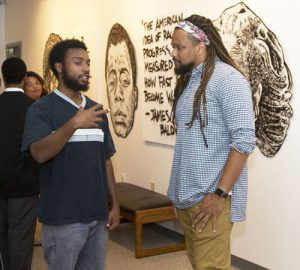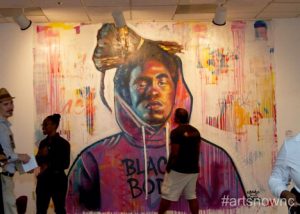
Brandan “Bmike” Odums is a visual artist, mentor and filmmaker who uses art and film to tell stories and make statements that transform the minds of viewers as well as the spaces in which his work appears. His work has been featured on the OWN drama series Queen Sugar. His current exhibit, “Be:tween Words,” is open in the African American Cultural Center Art Gallery through October 22, 2017 on the second floor of Witherspoon Student Center. Read Chaniqua Simpson’s recent interview with the artist.
What is your work about?
On the surface my work is mostly large scale with spray paint. Because of spray paint, I like to work as large as possible – five stories, three stories – as far as the work that’s outdoors. My indoor work is the same idea. I try to work as large as I can on canvas. Most of the canvases are between eight and fifteen feet tall.
As far as the meaning of the work, it is typically me speaking my truth as a Black man from New Orleans and just being truthful to the legacy of Black Arts and how Black Arts is more than ‘art for art’s sake.’ I think about the time that we are in, the moment that we are in, and the movement that we are in, and how my work and my voice lends to that choir.
What’s your favorite project?
 I don’t really have a favorite, but I feel blessed that things have been happening organically in terms of art and in terms of where I am. I know it can be frustrating to think about one’s self as an artist and how to get heard or get your work seen. But for me, it sort of just happened. As far as the visual arts side of it, I was responding to space – responding to the abandoned and displaced and forgotten buildings in New Orleans. I just started painting them and people paid attention and it just kept growing. So if anything, I think my favorite project would be the series that I’ve been doing in New Orleans. I’ve been painting in these non-typical/outdoor/forgotten buildings. Project Be, Exhibit Be, and Studio Be – they happened one after the other. Just seeing how people responded and how people took ownership of the work, it became more than just something I was doing for myself. So that would be what I’m most excited about.
I don’t really have a favorite, but I feel blessed that things have been happening organically in terms of art and in terms of where I am. I know it can be frustrating to think about one’s self as an artist and how to get heard or get your work seen. But for me, it sort of just happened. As far as the visual arts side of it, I was responding to space – responding to the abandoned and displaced and forgotten buildings in New Orleans. I just started painting them and people paid attention and it just kept growing. So if anything, I think my favorite project would be the series that I’ve been doing in New Orleans. I’ve been painting in these non-typical/outdoor/forgotten buildings. Project Be, Exhibit Be, and Studio Be – they happened one after the other. Just seeing how people responded and how people took ownership of the work, it became more than just something I was doing for myself. So that would be what I’m most excited about.
Was there any backlash to your work?
Yeah, I think there’s always the egregious forms where people are just angry about it. I guess they’re coming from a space about art and the outdoors – the conversation about “public art vs. graffiti” or “street art vs. graffiti.” There was backlash from the graffiti community initially. And there a few who still don’t like me in New Orleans. It’s because of the way it’s practiced in New Orleans. I would say it’s not unlike how it’s practiced in many cities – cities where graffiti has become like a Christopher Columbus/Manifest Destiny of settlers. There  are people who are not organically from the spaces where they do graffiti. They get excited about the adventure and the energy of it. Which I understand. I was excited about it too at one point, but I think my responsibility and my voice overwhelmed the practice itself of graffiti and so I saw that I had no choice but to be truthful for myself. But you find the spaces occupied by the people who are more interested in the adventure and not thinking about the weight about where they’re painting and why. Especially in New Orleans – why are the buildings that they are painting empty, and who used to live there, and why they’re no longer there. So these are questions that I had to answer with my own work. As a result of me answering those questions, people who were doing graffiti were sometimes not completely understanding and some of them were upset by the work that I was doing.
are people who are not organically from the spaces where they do graffiti. They get excited about the adventure and the energy of it. Which I understand. I was excited about it too at one point, but I think my responsibility and my voice overwhelmed the practice itself of graffiti and so I saw that I had no choice but to be truthful for myself. But you find the spaces occupied by the people who are more interested in the adventure and not thinking about the weight about where they’re painting and why. Especially in New Orleans – why are the buildings that they are painting empty, and who used to live there, and why they’re no longer there. So these are questions that I had to answer with my own work. As a result of me answering those questions, people who were doing graffiti were sometimes not completely understanding and some of them were upset by the work that I was doing.
Then there’s the backlash from the people who love and appreciate you. Their question is why do you spend so much time creating ephemeral work and why do you spend so much time creating pieces that won’t last and that will be destroyed. I think art is a tricky thing because people have so many different versions of appreciation. Some people want it to last forever. There are people who want it to be valuable from a price standpoint. Then there are people who want it to move them. All these people sometimes don’t dance to the same song.
So what’s your take on that?
I feel like for me, like James Baldwin said, “artists are here to disturb the peace.” Paul Robeson said, “Artists are the gatekeepers to the truth.” I feel at least those things don’t have to be tied to capitalism or commerce. I understand sustainability, so that’s definitely something that I’ve been focusing on with my projects in New Orleans. I ask, “How we can sustain this, not just for me, but for the people? How can we employ other people and employ the community?” But I think art at its best is supposed to be truthful. It’s supposed to be responsible. And I have fun doing it. I like turning nothing into something.
You’ve touched on this a little bit, how does your work connect to the larger political and racial climate?
Being that I feel that art has to come from a truthful place then there’s no way for me to create without acknowledging or adding the fact that these are words being spoken from a Black man. Because that’s who I am. That’s who I see when I look in the mirror. That’s the space that I operate in when I’m walking, especially in predominantly white spaces. Like W.E.B. DuBois talks about, I have a double consciousness of knowing that I’m Black, but I also think about “how do these people look at me as a Black man?” So I think my work reflects that. I am also super inspired by the Black Arts Movement. We are in a resurgence of that with this Movement for Black Lives. I think there’s a resurgence of Black Art that connects with this understanding of the many voices in one choir type thing. So I’m excited to be a part of that and I’m excited that it’s bringing artists, thinkers, movers and doers who are all playing their part and holding society accountable. At its best, I hope my art is truthful to this moment that we are in.
Are you excited about your visit to North Carolina and your upcoming NC State residency?
I am excited. I used to live in Jacksonville, North Carolina when I was in middle school. My father was in the Marines and he was stationed in Camp Lejeune. I have great memories in North Carolina and the “First in Flight” license place that we had on our SUV. It’s kind of dope to come back to the state and being able to do what I love to do. I feel like my time here as a middle school student/teenager helped to definitely foster and activate my desire to want to create and be creative and draw. I’m also excited about the opportunity to show my work. Like I said earlier, it can be stressful and intimidating to think of yourself as an artist. So I’m happy. When I get invitations like this, it makes me pleased that I’m doing something right or the universe is looking out for me in some way. I’m happy that I’m able to engage with folks outside of my bubble. Hopefully, I can help others either process things or see things that art can do. So I hope people come to the show and see themselves reflected and also challenge themselves to think differently.
What do you hope, if anything, students will get out of your exhibit?
I hope that students can see themselves reflected in the work and the potential of art. I hope they can see the potential that my story has – being from new Orleans and all the things that have happened in the last three or four years – a potential that is not something particularly special about me, but the idea that you can use your voice and be truthful. I also hope that students that don’t necessarily see themselves reflect that they are able to challenge themselves. I feel that artists are alchemists. Not only do we change canvases from empty sheets to something filled with art, we are able to change the way people look at themselves, and also the way people look at each other. So if anything I’m hoping that this art is able to be like an alchemist and transform and help water seeds that have been planted a long time ago.
Brandan “Bmike” Odums will be an artist-in-residence from October 16-22, 2017. If you have questions or would like BMike to attend programs, classes or events during this time, please contact the African American Cultural Center at aaculturalcenter@ncsu.edu.
- See also Brandan “Bmike” Odums’ website.
Chaniqua Simpson is a doctoral candidate in sociology and anthropology and a graduate intern at the African American Cultural Center.